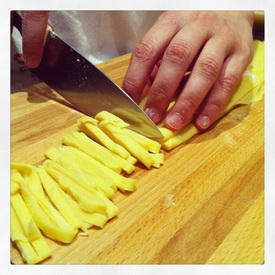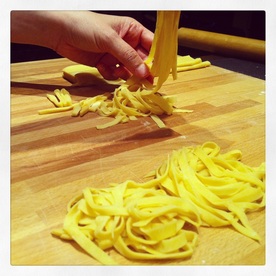
Once you've made the pasta dough, stretch it with rolling pin until you get a very thin dough surface, about 1-1,5 mm. Cover it with a cotton cloth, allowing it to dry slowly.
Once dry, roll the stretched dough into a 6-7cm wide cylindric shape which will tend to flatten on top. To prevent your dough from sticking, you can sprinkle some flour all over stretched dough before rolling it.
Cut the rolled dough into 6mm wide stripes for classic tagliatelle, 9mm for large tagliatelle and up to 12mm for a variety called pappardelle. Width depends on tastes as well as condiments that will go with your pasta.
Once dry, roll the stretched dough into a 6-7cm wide cylindric shape which will tend to flatten on top. To prevent your dough from sticking, you can sprinkle some flour all over stretched dough before rolling it.
Cut the rolled dough into 6mm wide stripes for classic tagliatelle, 9mm for large tagliatelle and up to 12mm for a variety called pappardelle. Width depends on tastes as well as condiments that will go with your pasta.

Finally, unroll the stripes creating small heaps of tagliatelle, size of a fist and place them delicately on the surface, making sure not to press them too much to avoid sticking.
Cook in plenty of boiling, salted water. Once the pasta starts emerging to the surface, it is done and should immediately be taken off the heat, adding a splash of cold water to the pot to stop the cooking process.
Drain the pasta, add it to the sauce in a pan and toss around quickly until mixed well.
Cook in plenty of boiling, salted water. Once the pasta starts emerging to the surface, it is done and should immediately be taken off the heat, adding a splash of cold water to the pot to stop the cooking process.
Drain the pasta, add it to the sauce in a pan and toss around quickly until mixed well.

